Affiliate disclosure: This post may contain affiliate links. Please see our Privacy Policy.
Wild grape wine is the perfect way to use your foraged grape harvest.
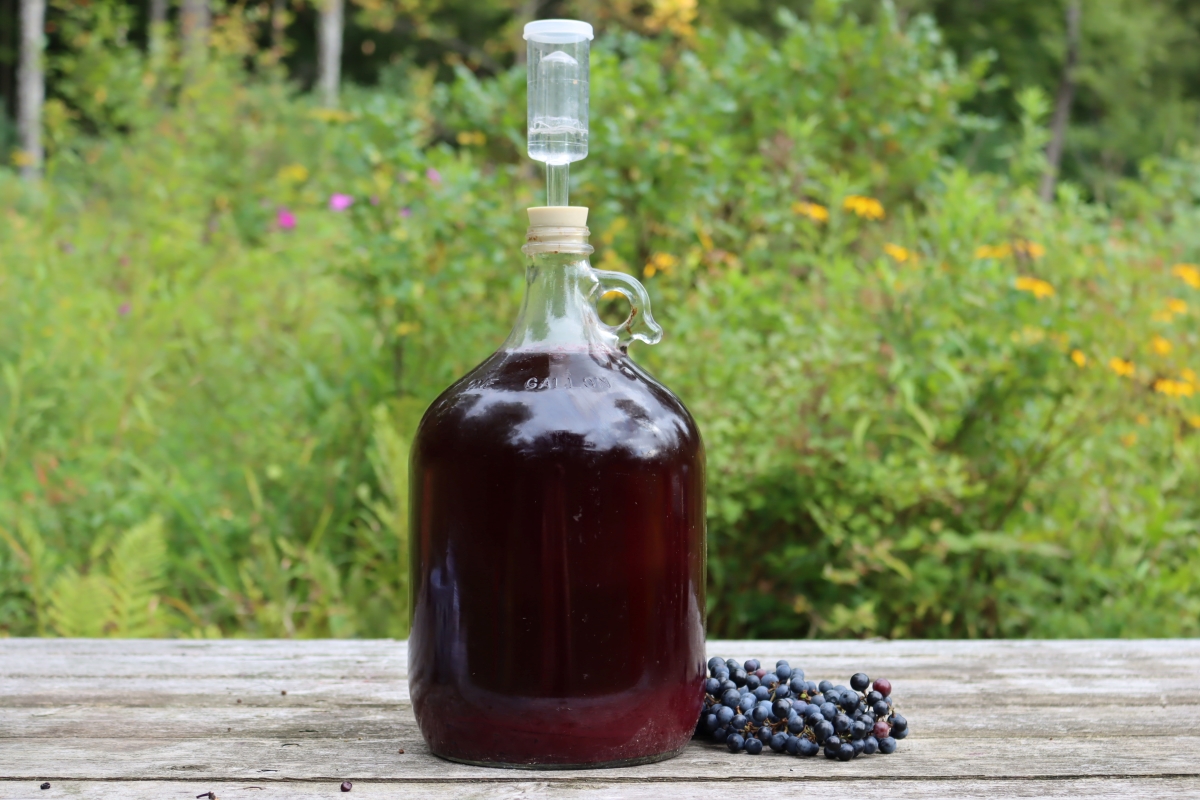
Wild grape wine is a spectacular way to make use of wild grapes. Although not as sweet as regular store-bought grapes, they contain plenty of tart flavors that balance well with some sugar or honey.
There are a wide variety of wild grapes out there, from fox grapes (Vitis vulpina) to summer grapes (Vitis aestivalis). There are even more obscure varieties like the possum grape, which are exceptionally tart.
The most common, however, is Vitis riparia, also called the riverbank grape or frost grape. This grape grows plentifully across North America, even becoming aggressive at times.
What better way to keep these vines in check than to harvest their fruit for winemaking?
In fact, no matter the variety, most wild grapes are ideal for winemaking. They only possess a few differences from regular grapes, the most prominent being their sweetness.
While cultivated grapes tend to be larger and sweeter, wild grapes are usually more acidic and tart. Some varieties also tend to be earthier or have a sweet muskiness to them.
These overflowing vines and their resulting fruit grow in abundance in many parts of the country, popping up along fences and wrapping around trees. Foraging for wild grapes can quickly yield enough for a lovely batch of wild grape wine or mead.
Making wine from grapes follows the same basic process as with any small-batch country wine.
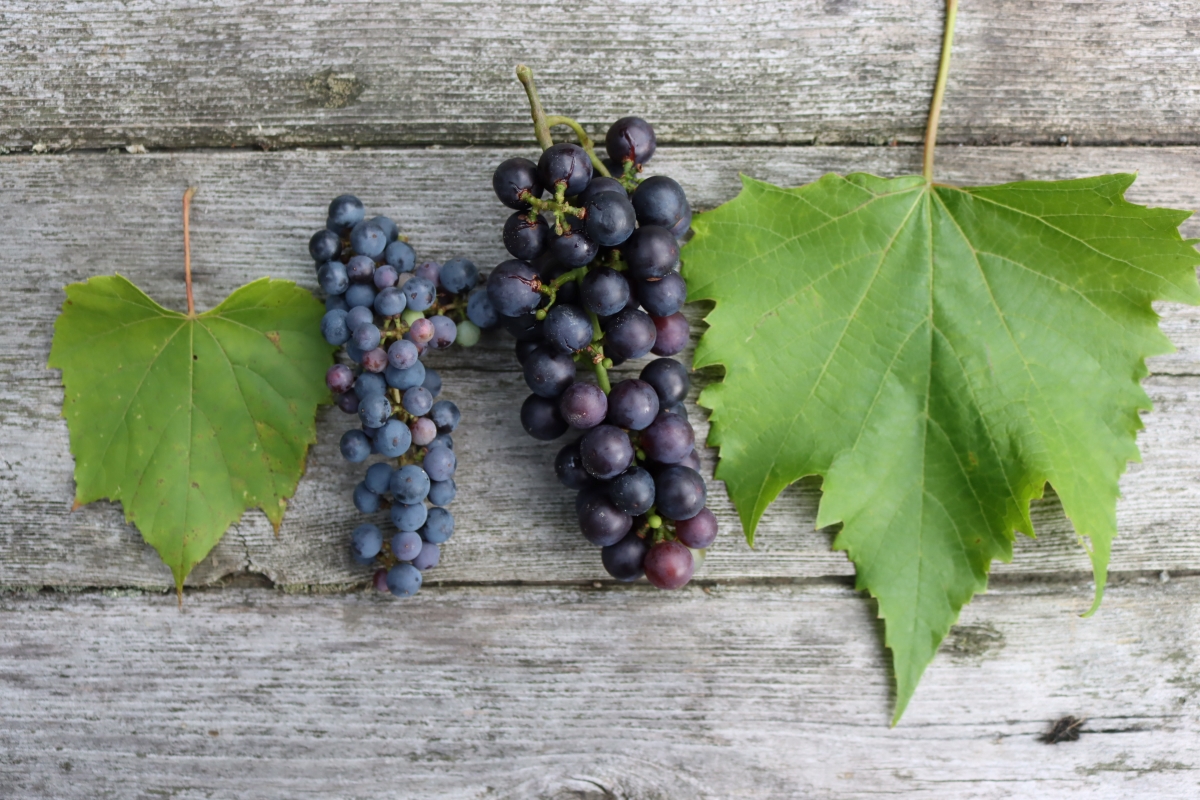
You’ll start with some fruit, which can either be juiced or placed in a brew bag for the primary ferment, and combine it with sugar and a few other winemaking additives (just a wine yeast, yeast nutrient and pectic enzyme).
After allowing the mixture to ferment for 7 to 10 days, the active fermentation will slow. Now the wine can be siphoned to a new fermentation vessel (minus the fruit and sediment) where it will ferment more slowly for 6 weeks to 6 months.
After that, it’s time to bottle the wine, let it mature, and simply wait for time to perfect your concoction.
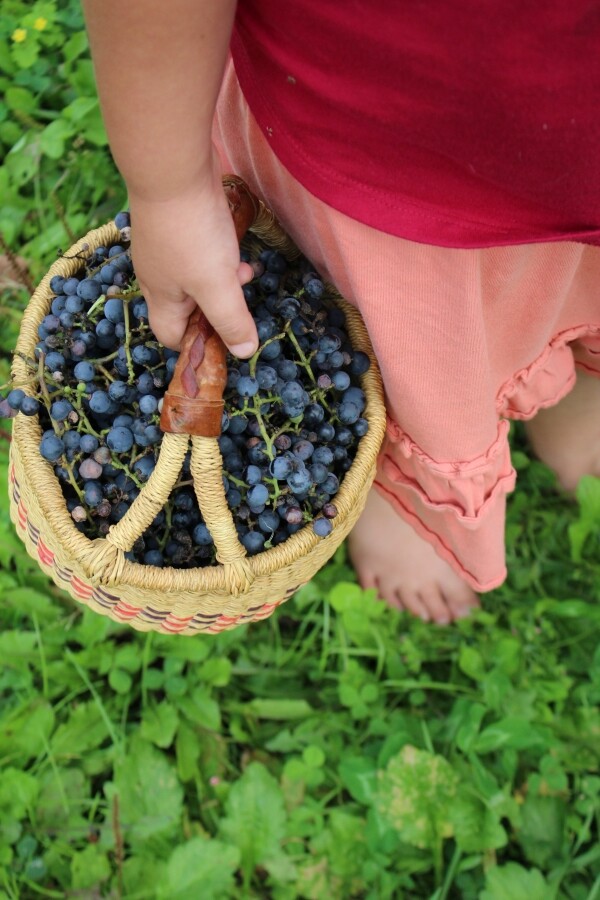
This recipe has been written for those familiar with the principal winemaking terms and protocols. If you’re newer to winemaking (or could just use a quick brushup on some of these elements), these fundamental guides should help a good deal:
- Beginners Guide to Making Fruit Wines is a great place to start for beginners and covers all the steps in the winemaking process.
- How to Make Mead (Honey Wine) is largely the same, but is a must-read for those working with honey, as there are a few particularities with it.
- Equipment for Winemaking will take you through all the equipment needed (other than your ingredients).
- Ingredients for Winemaking will tell you everything about your ingredients and what they do.
- Yeast for Winemaking is a fascinating field. There are both common strains and hundreds of obscure ones. See it all broken down for you here and discover which is the best for your batch.
Ingredients for Wild Grape Wine
To make wild grape wine, the ingredient list is relatively short.
If you’re curious as to what each of these things do, you can check out this post on winemaking ingredients to understand the role of these ingredients in small-batch winemaking.
You will need the following ingredients to make a one-gallon batch of wild grape wine:
- 5 to 6 lbs of wild grapes
- 2 lbs of sugar (about 4 cups) or honey for mead
- 1 tsp Yeast Nutrient
- ½ tsp Pectic Enzyme
- Wine Yeast
You won’t need any wine tannin or acid blend for wild grape wine as wild grapes are quite acidic on their own, and there are plenty of tannins in the grape skins and seeds. All you’ll need besides wild grapes and sugar, is a little bit of yeast nutrient, a pectic enzyme, and a nice wine yeast.
As for wine yeast, Montrachet and Champagne yeasts like Lalvin EC-1118 are always reliable choices. For a nice red wine, Pasteur Red is also a good option. Red Star Cote des Blanc is another general purpose yeast to use for both reds and whites producing a sweeter result.
The yeast nutrient will help keep your yeast healthy and active. Additionally, the pectic enzyme will help the wine to clear as grapes are actually quite high in pectin.
You’ll need 5 to 6 lbs of wild grapes to make a nice, flavorful wine. Using a steam juicer will be the most efficient way of extracting the juice, but you can also simply crush grapes and place them in a brew bag for your primary ferment.
That’s all you’ll need in terms of ingredients. Equipment-wise, you’ll also need the following:
- One Gallon Wide-Mouth Carboy if including grapes in primary fermentation
- One Gallon Narrow-Neck Carboy for secondary (frequently sold in a kit with a rubber stopper and water lock together)
- Rubber Stopper and Water Lock (if not included above)
- Brewing Siphon
- Wine bottles or Flip-top Grolsch bottles
- Bottle Corker and clean, new corks for bottling
- Brewing Sanitizer
Making Wild Grape Wine
You have two options when making wild grape wine. You can juice the fruit for your primary ferment or place grapes in a brew bag and crush them, leaving the bag in for your primary ferment. The choice is yours. Be sure to stem the grapes though, if using the whole fruit.
If you decide to leave the grapes in for primary ferment, you’ll need to use a wide-mouth carboy. If all you have is a narrow-neck, juicing will be the best option.
You can also use a brewing bag in a fermentation bucket for primary, which helps keep things clean and you can easily remove the brew bag and pomace.
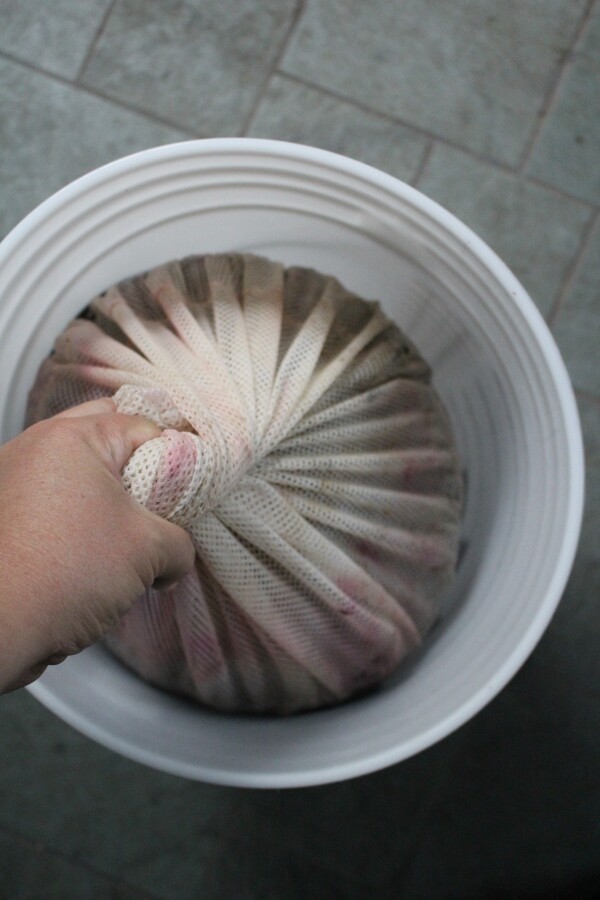
After either crushing your fruit or juicing it, move it to your carboy. Add about ½ gallon of water along with 1 pound (2 cups) of the sugar. Next, add the yeast nutrient and pectic enzyme and stir to dissolve.
Add your wine yeast last, being sure to rehydrate first.
Adding the yeast straight to your wine mixture can shock the yeast. To avoid this, rehydrate it first in a small amount of room temperature water for 10 minutes before adding it to the wine.
Add more water if needed to fill the carboy and seal it with a water lock.
You should see a nice, active fermentation occurring in the next 24 to 72 hours, with plenty of bubbling.
Ferment in primary for 7 to 10 days. You should notice the bubbling has mostly stopped at this point.
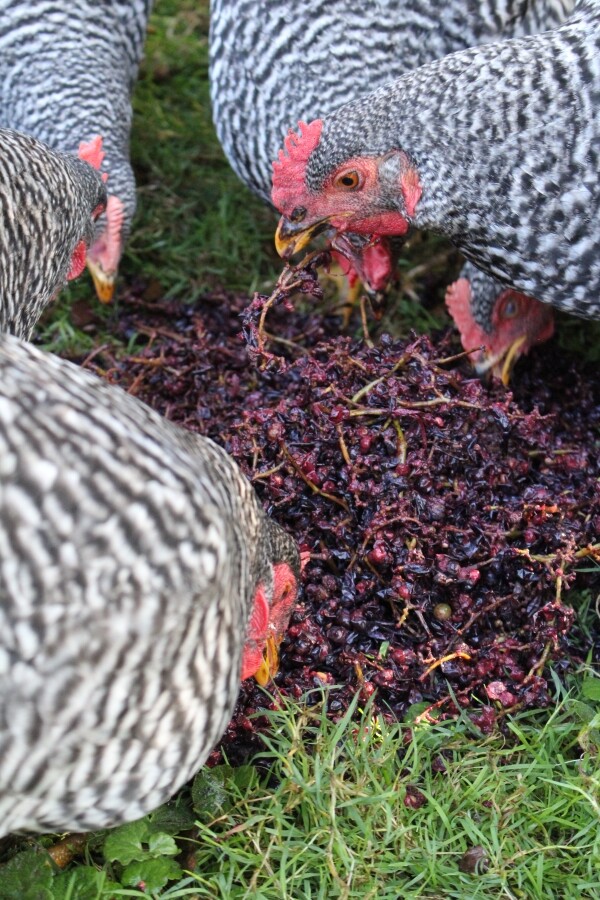
Siphon the wine to a clean carboy for secondary, leaving the sediment behind and discarding your brew bag. Add the remaining pound of sugar (dissolved in a little water) and more water as necessary to fill the carboy.
Seal with a water lock and continue to ferment the wine until it clears. You may need to rack the wine again to help discard the sediment. Sediment can cause off-flavors in your wine if left unattended.
Wild grape wine can spend anywhere from 4 weeks to several months in secondary (4 months is usually the recommended minimum). For wild grape mead (or rather, grape pyment) the time can be even longer. Honey is more difficult for your yeast to digest than sugar, resulting in a longer ferment time (around 6 months is best).
Once you’ve reached the end of secondary, give the wine a sample. The wine, although still rough, should be balanced at this point and give you a general sense of the final flavors. If too dry, you do have the option to backsweeten before bottling.
To backsweeten, rack your wine to a clean container and stabilize the wine first by adding 1 Campden tablet and ½ teaspoon potassium sorbate. Wait 24 hours, then add sugar to taste. This should be done by creating a simple syrup of equal parts sugar and water, and adding that to your wine. Seal with your water lock and leave for another week before bottling to ensure fermentation does not restart.
If you’d rather not stabilize the wine, you can always add sugar and put it back into ferment until all signs of active fermentation have stopped (about a month).
Once bottled, let the wine mature for at least a month before drinking. A longer bottleage is better though, so wait a little longer if you can!
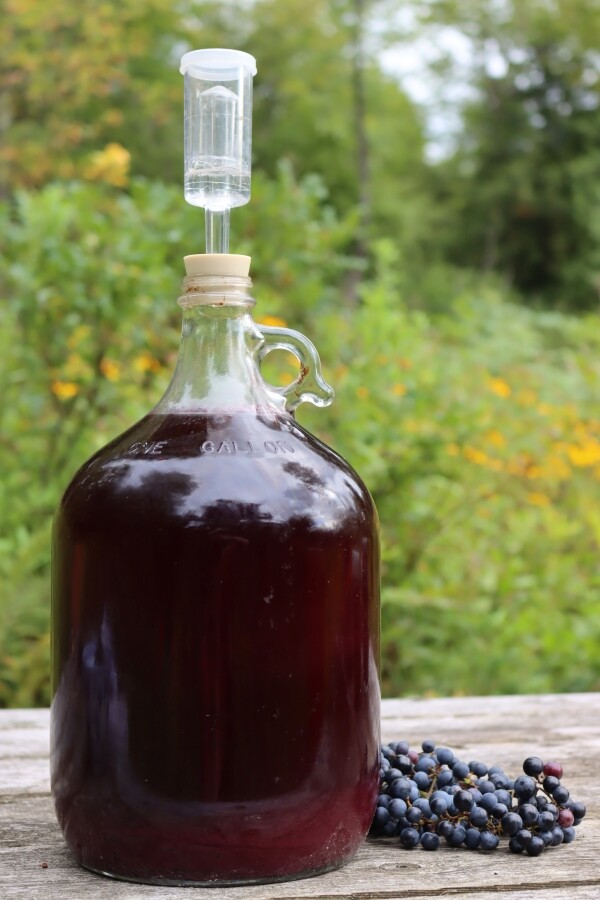
Ways to Preserve Wild Grapes
Searching for even more ways to preserve wild grapes?
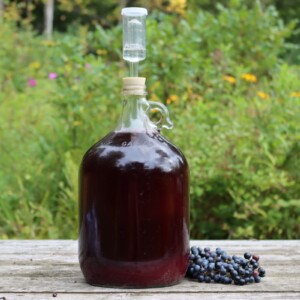
Wild Grape Wine
Equipment
Ingredients
- 5 to 6 lbs wild grapes
- 2 lbs Sugar, about 2 cups per pound
- 1 tsp yeast nutrient
- ½ tsp Pectic Enzyme
- 1 packet wine yeast, see note
- Water, to fill
- Optional ~ Campden Tablet and Potassium Sorbate for Stabilizing, I do not use these
Instructions
- De-stem the grapes, place them in a brew bag and crush. Optionally, you can juice grapes.
- Place grapes or grape juice in your carboy, and add about ½ gallon of water and 1 pound (2 cups) of sugar. Stir to incorporate.
- Add the pectic enzyme and yeast nutrient, stirring to dissolve.
- Add the wine yeast last, rehydrating first in a small amount of water.
- Add water as needed to fill the carboy and seal with a water lock.
- Let ferment in primary for 7 to 10 days.
- Siphon to a clean narrow-neck carboy for secondary, leaving sediment (and fruit) behind. Add the remaining 1 pound (2 cups) of sugar dissolved in water.
- Add water to fill the carboy and seal it with a water lock. Ferment until clear, racking again if needed to clear sediment.
- At the end of secondary, taste the wine and adjust as needed (see notes for backsweetening).
- Bottle the wine with wine corks and let age for at least 1 month before drinking.
Notes
Amount of Fruit
You'll need about 5 to 6 lbs of wild grapes to yield 1 gallon of wild grape wine. If juicing your grapes, the juice is normally diluted with water as wild grapes are intensely flavored and highly acidic.Yeast
For wild grape wine (or pyment), you’ll want a yeast with a moderate alcohol tolerance. Montrachet and champagne yeast are good choices (Lalvin EC-1118 is a nice, strong fermenter). Pasteur red is a nice choice for red wines. Red Star Cote de Blanc is another good general purpose yeast.Stabilizing and Back Sweetening
If the wine is too dry for your tastes, you have the option of backsweetening before bottling. To backsweeten wild grape wine, rack it to a clean container and stabilize the wine by adding a Campden tablet and ½ teaspoon potassium sorbate. This prevents fermentation from restarting and causing bottled wine to burst under the resulting pressure. Wait 24 hours after stabilizing, then add sugar in the form of a simple syrup (made by heating equal parts sugar and water on the stovetop.) Amounts needed will vary based on personal preference, but starting with ½ cup for one gallon of wild grape wine is a good place to start.Nutrition
Nutrition information is automatically calculated, so should only be used as an approximation.
Fall Winemaking Recipes
Looking for more late season wines to make this autumn?
- Apple Wine
- Cranberry Wine
- Elderberry Wine
- Persimmon Wine
- Pomegranate Wine
- Beetroot Wine
- Parsnip Wine
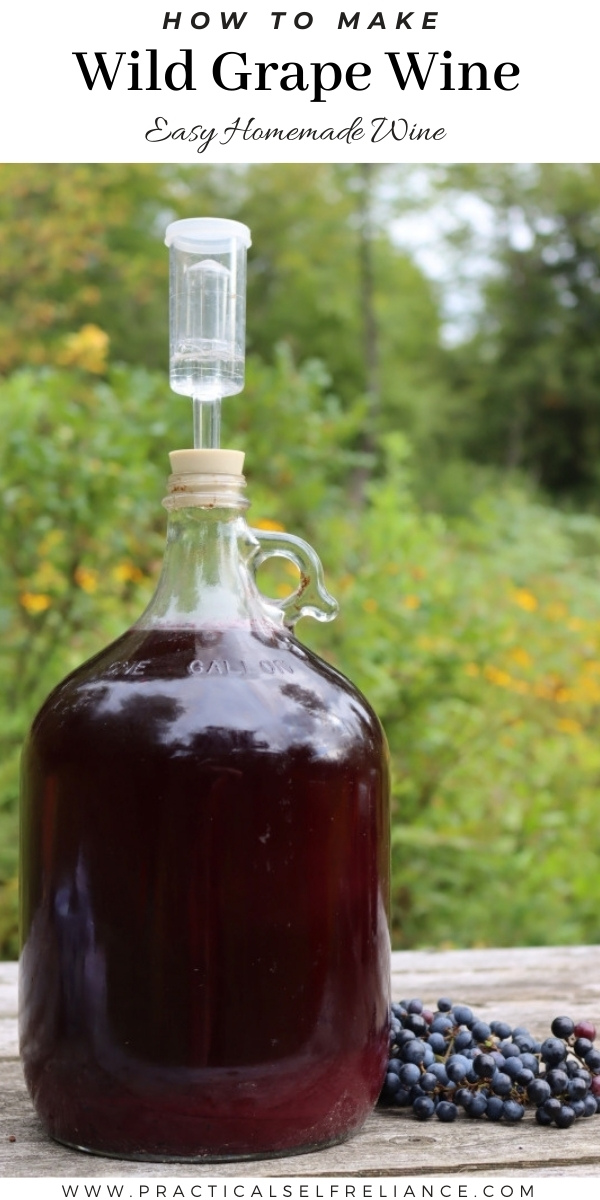



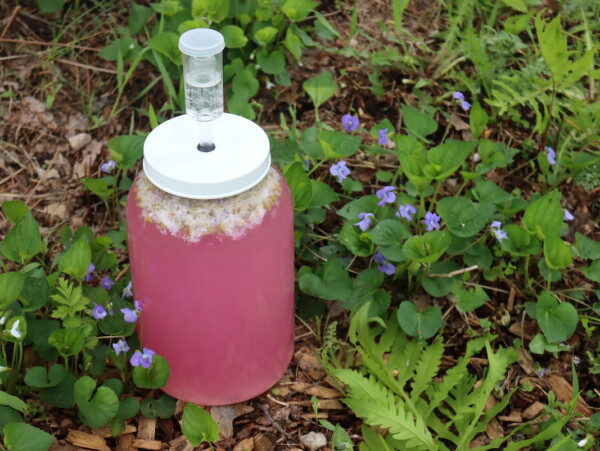










How much grape juice would you use? I had a bunch of wild grapes that I already made juice out of.
This recipe is for a gallon so I would use a little less than that to make sure you have room for the other ingredients.